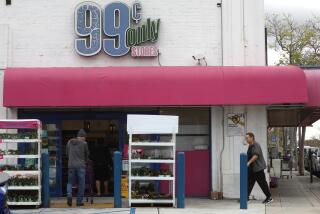Best Buy can be saved by offering expertise and good service
How can Best Buy be saved?
The question has been swirling around the huge retailer for a couple of years, as its same-store sales have been falling. But it picked up steam last week with the sudden resignation of Chief Executive Brian J. Dunn, who had been in his job less than three years.
The unceremonious departure of Dunn, 51, looked at first as though it was connected with his professional performance, which hadn’t thrilled many Best Buy watchers. But it soon transpired that the reason had something to do with questionable personal conduct, reportedly involving a female subordinate.
Dunn’s method of leaving his job was the most modernistic step he’s taken in years — personal behavior has been trending higher in recent years as a rationale for top-level firing in both industry (think Hewlett-Packard’s Mark Hurd) and sports (Arkansas football coach Bobby Petrino).
In most other respects, Best Buy under Dunn’s leadership was moving backward. The stores have been looking more forlorn and less like the teeming shoppers’ carnivals of years past, and the inventory choices shrinking. Meanwhile the sales staff comes off as less knowledgeable and more indifferent. Former customers of the extinct Circuit City and Border’s, the last big retailers to go down this road, must be feeling a sense of deja vu.
Best Buy once was one of my favorite retailers. There was a period when I lived in virtually an all-Best Buy household; the chain sold us our flat-screen TV, most of our stereo equipment, desktops and laptops, even a high-tech vacuum. My frequent-buyer account got me cash-back coupons and longer grace periods on returns.
The last time we bought a refrigerator, however, we got a better price and payment terms from Sears for a comparable unit. Here’s a retailing maxim: If you’re losing sales to Sears, you’re in trouble.
The challenges facing Best Buy are easy to discern. It’s caught between the Scylla and Charybdis of Apple and Amazon.com. Apple has become a retail juggernaut, generating astronomical sales estimated at $5,600 per square foot at its snazzy toy-stores-for-grown-ups.
Best Buy’s figure, according to its most recent annual report, is $866 per square foot — respectable for a retailer in its class, if not in Apple’s league. Amazon consistently beats Best Buy on price, even without counting the advantage it gets by not charging sales tax for many customers outside its home state of Washington.
That advantage will soon be extinct in California, as it is in several other populous states. But even without the sales tax bump, Amazon beats Target andWal-Mart as well as Best Buy on the prices of many items, as investment analysts at William Blair & Co. recently documented.
Like Best Buy, those chains suffer from “showrooming,” in which customers try out merchandise on their sales floors and then place their orders at Amazon for less money. But Target and Wal-Mart aren’t facing the sickness unto death that appears to be confronting Best Buy. Not at the moment, anyway.
Sure, judging Best Buy against premier marketer Apple and online-only Amazon is a mite unfair. Apple stores sell essentially five branded products with cult-like followings (Mac desktops, Mac notebooks, the iPad, the iPhone and the iPod).
Amazon doesn’t have to build and maintain walk-in stores; on the other hand, after launching in 1995, it spent so relentlessly on distribution and technology systems that it didn’t show a profit until 2003. But that spending yielded what today stands as the best customer experience on the Web.
Every retailer is different, like Tolstoy’s unhappy families, and good lifeline-caliber ideas can be found anywhere. The architect of Apple’s retail store strategy, Ron Johnson, came from Target at a time when Apple’s lack of any retail strategy threatened its very existence. (He was abetted by alumni of Gap, whose founder, Millard Drexler, had joined the Apple board.) Johnson last year was recruited to reviveJ.C. Penney, whose board must think he knows a few things that will transfer to the non-Apple marketplace.
Nothing is stopping Best Buy from picking out the best ideas in the field and adapting them to its own space. At least that would be an improvement over its current strategy, which seems to be to pick out everyone’s worst ideas and try to take them to the bank. These include its shift toward smaller, mall-based storefronts with limited merchandise.
Dunn’s last major announcement before resigning was that he would close 50 of the chain’s 1,100 U.S. big-box stores while expanding small-format locations. One example of the latter is the Best Buy Mobile store I visited the other day in a Lakewood mall. The store was clean, but small enough to give a claustrophobe fits. The two salesclerks were friendly and helpful without being pushy; it’s not their fault that it’s hard to imagine that Best Buy’s future lies in storefronts the size of bathroom stalls.
So what are the best ideas?
One is that expertise sells. The first Apple stores opened in early 2001 — believe it or not, this was before the iPod. Since then, they’ve built on the company’s reputation for hip design and first-class technical service. The products are laid out on tables to encourage the touchy-feely experience. Employees are ubiquitous but unobtrusive.
The techs at the Genius Bar seem trained in Apple technology to the last brain cell. The hard sell is so deeply submerged in the store experience that you may not even know you’ve been sold until you’re out the door with a MacBook in hand. But you’ll think the staff has identified your need and found a way to meet it.
Another retail lesson worth internalizing is that a chain doesn’t have to be pitched toward the affluent to offer good service.
Nordstrom, which occupies a high-end market segment, is known for its attentive sales staff. But walk into aMen’s Wearhouse and you don’t have to chase after a salesperson with a butterfly net — typically you’re greeted promptly by someone in full command of the inventory on the floor. By the way, Men’s Wearhouse collects more revenue per square foot of selling space than Nordstrom ($451 versus $431), according to the firms’ most recent annual reports.
Put these two notions together, and you might just have a new Best Buy paradigm. As our lives become more enslaved by technology, the need for expert help sorting out how best to integrate every Bluetooth- and Wi-Fi-enabled thing grows greater.
Best Buy nodded to this reality with its techie-staffed Geek Squad. The Squadsters are not especially well-trained to divine a customer’s tech-related problems and cobble together a solution from all the inventory at hand. In any case, the last time I was in a store, two of them gave me two completely different answers to the problem I brought them; I suppose it’s to their credit that only one of them was wrong.
The chain could do worse than to hire and train more employees with real knowledge of technology and an incentive to solve customers’ dilemmas instead of selling them useless extended warranties, which is by far the most offensive aspect of dealing with Best Buy.
And how about staffing up? It hasn’t been unusual for the first salesperson to accost me inside a Best Buy to be an embedded sales agent for a service such as Verizon or DirecTV. Yet Dunn’s big idea in the last Christmas season was to hire only half as many seasonal workers as the year before.
Then there’s the dilemma of online. Conventional retailers wasted years treating their online arms as though they were fifth columns. Until fairly recently, I couldn’t even use my Best Buy frequent-shopper rebate coupons on Bestbuy.com.
Best Buy’s online integration has been so poor that in the week before Christmas it canceled what may have been thousands of online orders placed as early as November for lack of inventory, certainly a mortal sin in customer service.
The chain may be crippled by “showrooming,” but why not offer customers looking over items in the store an incentive to place their orders through Bestbuy.com rather than Amazon? And the company may have to bite the bullet and extend its price match policy to cover not only its brick-and-mortar competitors but online merchants too.
All this points to lower profit margins ahead, but that’s the cost of investing in new strategy and tactics. But if the choice is between rebuilding your customer base or letting it fade away like those of Circuit City, CompUSA and other retailers done in by, well, Best Buy, the road is clear. The worst thing that could happen to the chain is for the question to change from “how Best Buy can be saved” to “can it be saved,” especially if the answer is no.
Michael Hiltzik’s column appears Sundays and Wednesdays. Reach him at mhiltzik@latimes.com, read past columns at latimes.com/hiltzik, check out facebook.com/hiltzik and follow @latimeshiltzik on Twitter.







